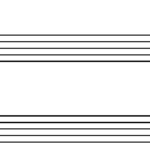If you’re on the hunt for the best acoustic guitar strings, you’ve likely landed here for good reason. Whether you’re seeking a change from your usual strings, or you’re a newcomer to the acoustic guitar world needing guidance, you’re in the right place. With over two decades of guitar playing experience and a collection spanning from travel guitars to classical guitars, I’m here to help you navigate the choices and find the perfect strings for your acoustic.
Choosing guitar strings is a deeply personal experience. For me, the string gauge is the paramount factor. While different brands might offer subtle variations in feel, the gauge is what truly dictates the playability and sound of your instrument. Switching brands might bring minor changes, but altering the gauge can revolutionize your guitar’s performance. I delve into the nuances of string gauge in the FAQs section later in this article, so be sure to explore that for a deeper understanding.
Another critical decision is whether to opt for coated or uncoated strings. These two types present distinct differences in both feel and sound. Personally, I perceive coated strings as slightly less vibrant than their uncoated counterparts. However, for live performances, coated strings are indispensable due to their longevity. Conversely, for home practice or recording, I lean towards uncoated strings where sound quality is paramount.
Making these choices can feel overwhelming, which is why many players tend to stick with familiar options. However, I wholeheartedly recommend experimenting with different string types and gauges on all your guitars. This exploration can dramatically alter the sound and playability, injecting fresh inspiration into your playing, especially if you feel creatively stagnant. Below, I’ve curated six of the best acoustic guitar strings currently available, each uniquely suited for different needs and preferences. Let’s dive in.
Best Acoustic Guitar Strings: Product Guide
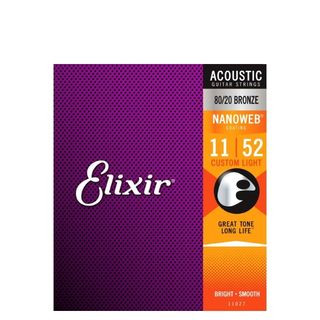 Best acoustic guitar strings: Elixir Nanoweb 80/20 Bronze
Best acoustic guitar strings: Elixir Nanoweb 80/20 Bronze
Best Overall
1. Elixir Nanoweb 80/20 Bronze
Material: 80/20 bronze
Coating: Nanoweb
Pros:
- Superb sound quality
- Extended lifespan
Cons:
- Higher price point
Elixir Nanoweb 80/20 Bronze strings are my go-to choice for all my gigging acoustic guitars. If durability and longevity are your priorities, these strings are hard to beat. Regularly wiping them down after playing further extends their lifespan.
While some players might initially find the coated feel unfamiliar compared to traditional uncoated strings, Elixirs, in my experience, closely mimic the feel of uncoated strings better than other coated options.
The sound profile is slightly more subdued compared to some uncoated strings, but unless you’re recording with high-end condenser microphones, this difference is negligible. In fact, they can be an excellent solution for overly bright-sounding acoustic guitars, helping to temper the high frequencies.
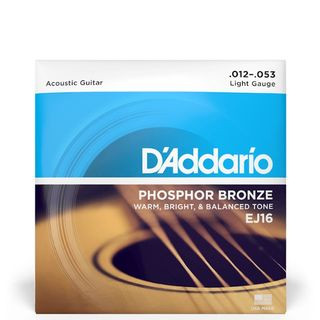 Best acoustic guitar strings: D’Addario EJ16
Best acoustic guitar strings: D’Addario EJ16
Best for Beginners
2. D’Addario EJ16 Acoustic
Material: Phosphor Bronze
Coating: N/A
Pros:
- Excellent value for money
- Wide range of gauges available
Cons:
- Shorter lifespan compared to coated strings
D’Addario EJ16s have been a staple in my string collection for years. In fact, they were the first set of acoustic strings I ever purchased, back when pop-punk was dominating the airwaves.
I continue to use them because of their exceptional combination of affordability and the vast selection of gauges. This versatility makes them ideal for experimenting with different gauges across various acoustic guitars to optimize playability.
Sound-wise, they are fantastic, delivering a clear and resonant voice to any acoustic guitar. The primary drawback is their uncoated nature, which means they won’t last as long as coated strings. However, given their price point, frequent string changes aren’t a significant concern for most players.
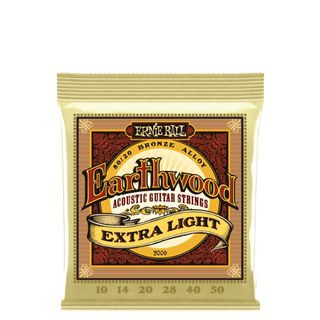 Best acoustic guitar strings: Ernie Ball Earthwood
Best acoustic guitar strings: Ernie Ball Earthwood
Best Budget
3. Ernie Ball Earthwood
Material: 80/20 Bronze
Coating: N/A
Pros:
- Extremely affordable
- Well-balanced sound
Cons:
- Can produce more finger squeak
While I predominantly use Ernie Ball Slinky electric guitar strings, a renowned brand in the electric realm, their acoustic strings, particularly the Earthwood range, often go underappreciated.
Ernie Ball Earthwood strings are an outstandingly cheap option that delivers excellent performance, especially for players on a budget. While not my primary choice, I wholeheartedly recommend them to beginners seeking their first string set.
The overall sound quality is impressive for the price, although I’ve noticed they tend to produce slightly more finger squeak compared to some other strings on this list. If you’re keen on exploring different gauges without breaking the bank, these are an excellent choice.
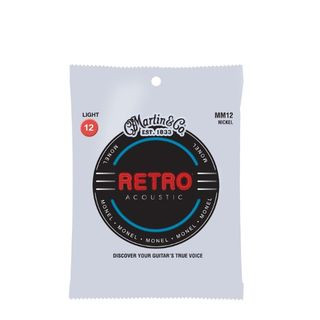 A packet of Martin Retro acoustic guitar strings
A packet of Martin Retro acoustic guitar strings
Best for Fingerpicking
4. Martin Retro
Material: Nickel Copper
Coating: N/A
Pros:
- Warm and mellow tone
- Good value
Cons:
- Not as bright as other options
While there isn’t a strict requirement for specific strings for fingerpicking, I prefer strings that are less bright and trebly for my fingerstyle acoustic guitars.
Martin Retro strings perfectly fit this preference, offering a noticeably warmer tone right out of the box compared to typical sets. This warmer sound is attributed to the nickel/copper wrap, differing from other strings on this list and resulting in a more toned-down sonic character.
I was pleasantly surprised by their longevity for uncoated strings. While the warmer tone might not appeal to everyone, I believe they are an excellent choice for fingerstyle players seeking a mellower sound.
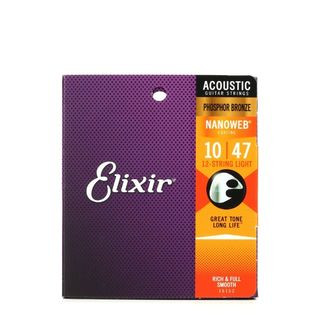 A pack of Elixir Nanoweb 12-string acoustic guitar strings
A pack of Elixir Nanoweb 12-string acoustic guitar strings
Best for 12-String
5. Elixir 12-string
Material: Phosphor Bronze
Coating: Nanoweb
Pros:
- Quick settling and tuning stability
- Long-lasting performance
Cons:
- Higher cost
Restringing a guitar is seldom enjoyable, but restringing a 12-string guitar is particularly tedious. While I currently own only one 12-string guitar, I dread every string change.
My primary reason for favoring Elixir strings on my 12-string is the extended lifespan provided by the coating, reducing the frequency of string changes. Although they are more expensive, the saved time and effort are well worth the investment.
I also appreciate the sound on a 12-string. Excessive overtones can be quite pronounced on 12-string guitars, but Elixir’s coating slightly mutes these, resulting in a more balanced sound. They also settle in and stabilize in tuning much faster than uncoated sets.
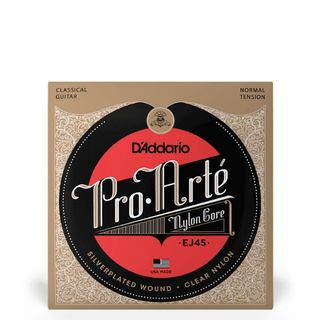 Best acoustic guitar strings: D’Addario EJ45 Pro-Arte
Best acoustic guitar strings: D’Addario EJ45 Pro-Arte
Best Nylon
6. D’Addario EJ45 Pro-Arte
Material: Nylon, Silver-Plated Copper
Coating: N/A
Pros:
- Warm and rich sound
- Balanced tension
Cons:
- Some players prefer high tension for louder volume
If you’re restringing a classical guitar, D’Addario EJ45 Pro-Arte nylon guitar strings are, in my opinion, among the best available. Two of my classical guitars are currently strung with these sets, and they perform exceptionally well.
D’Addario employs a multi-filament nylon core, which translates to consistent responsiveness and a warm tonal character. The treble strings are clear without being overly bright, facilitating a balanced sound, especially for fingerpicking.
I prefer the normal tension set, which offers a good equilibrium between playability and projection. Players seeking greater volume, particularly for purely acoustic performance, might prefer the high tension set, which D’Addario also offers for classical guitars.
FAQs
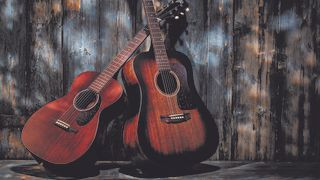 Two acoustic guitars on dark background
Two acoustic guitars on dark background
(Image credit: Future)
What is the best string gauge for acoustic guitars?
String gauge refers to the thickness or diameter of a string. A larger gauge indicates a thicker string. Gauge significantly impacts playability and tone, and also influences playing style.
Guitar strings are measured in thousandths of an inch and sets are typically identified by the gauge of the thinnest string, the high E. For instance, a “set of 12s” has a high E string with a 0.012-inch diameter.
Thicker strings generally produce a fuller sound, are louder than thinner strings, and have a rounded, bass-heavy low end. They are also more durable, a considerable advantage, but they also have drawbacks.
If you’re still developing hand strength, thicker gauges can make playing challenging, especially for string bending and fast passages. However, if you’re a heavy strummer or prefer lower tunings, thicker gauges are beneficial.
Lighter gauge strings are easier to fret and bend and sound brighter. The trade-off is a reduction in deep bottom-end frequencies. For some players, this trade-off is worthwhile, but not for everyone.
Consider your guitar’s body size. Smaller-bodied acoustics might be better complemented by lighter gauge strings. Conversely, dreadnought or jumbo-sized acoustics might benefit from thicker strings. However, there’s no strict rule. Some players use heavier strings on smaller guitars for added depth, and vice versa. Experimentation is key!
Which acoustic strings are best for beginners?
For beginner acoustic guitar players, selecting appropriate strings is crucial. You’ll want strings that balance playability and tone. Understanding string gauges and their impact on sound and playing experience is essential.
Here are common generic acoustic guitar string gauges. Variations exist between brands, and some brands offer hybrid sets, but this serves as a general guideline:
Extra light: .010 .014 .023 .030 .039 .047
Custom light: .011 .015 .023 .032 .042 .052
Light: .012 .016 .025 .032 .042 .054
Medium: .013 .017 .026 .035 .045 .056
Heavy: .014 .018 .027 .039 .049 .059
For standard tuning, Extra Light or Custom Light strings are recommended. These might be labeled as “set of 10s” or “set of 11s” and offer a bright, punchy tone with lower string tension, making them easier to play. As you gain comfort, try heavier strings, but super heavy gauges aren’t necessary unless your playing style demands it.
Note that electric guitar string gauges differ in nomenclature. Avoid direct comparisons between acoustic and electric gauges, as acoustic guitars generally require heavier strings for optimal sound.
When should I change my acoustic guitar strings?
The frequency of string changes depends on playing frequency, but as a general rule, restring your acoustic guitar at least every couple of months. This maintains optimal feel and sound. Coated strings might last longer, but once strings sound or look dull, replacement is due.
What are acoustic guitar strings made of?
Acoustic guitar strings are commonly made from bronze, phosphor bronze, brass, nickel, silk, and steel.
Each material offers unique tonal characteristics. Bronze is bright with bell-like clarity and a treble-focused response. Phosphor bronze adds phosphor to bronze to slow oxidation and extend lifespan, resulting in a slightly darker, warmer tone than bronze.
Brass strings offer top-end jangle, while nickel strings have a warmer, vintage tone. Monel, a nickel-based alloy, is also favored by some guitarists for its tonal properties.
Are nylon guitar strings easier to play?
Yes, nylon guitar strings are easier to play. Nylon strings are categorized as high or low tension, with high tension feeling heavier and low tension being easier to play. Even high-tension nylon strings have less tension than steel or bronze strings, making them beginner-friendly, especially on classical guitars.
Classical string sets have top three strings made of clear or rectified nylon and bottom three strings typically use bronze or silver-plated copper wire wrapped around a multi-filament core. Nylon strings are exclusively for classical guitars. Do not use steel strings on classical guitars, as the higher tension can severely damage the instrument.
How we choose the best acoustic guitar strings
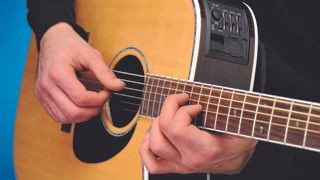 Man plays chord on acoustic guitar
Man plays chord on acoustic guitar
(Image credit: Future)
When evaluating acoustic guitar strings, thorough testing over time is crucial to ensure they are suitable for your acoustic guitar.
I begin by stringing my acoustic guitar with a fresh set and observing how long they take to “bed in” or stabilize. This assesses how quickly strings stretch and maintain tuning stability. The best sets stabilize within a few hours with some playing.
Next, I evaluate string feel under my fingers, looking for smoothness and absence of imperfections that might hinder playing. For coated strings, ideally, the coating should be imperceptible, which is generally the case with quality coated strings today. Coated strings invariably feel slightly different from uncoated ones.
Corrosion is a primary reason for string replacement. To test string lifespan, I leave strings on the guitar for an extended period, noting when discoloration, tarnish, and loss of brilliance occur.
Throughout testing, I listen attentively to the string’s sound across various playing styles, songs, and environments, monitoring how they respond and change over time.
With extensive experience listening to numerous acoustic guitars and string sets, my assessments are grounded in considerable experience. Ultimately, sound preference is subjective, and I acknowledge that my sonic preferences may differ from others.
Learn more about how we test music-making gear and services at MusicRadar.

